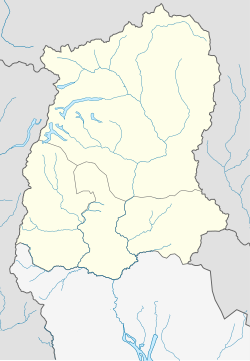Rabdentse
| Rabdentse | |
|---|---|
| town | |

Ruins of Rabdentse Palace
|
|
| Location in Sikkim, India | |
| Coordinates: 27°18′04″N 88°15′14″E / 27.30111°N 88.25389°ECoordinates: 27°18′04″N 88°15′14″E / 27.30111°N 88.25389°E | |
| Country |
|
| State | Sikkim |
| District | West Sikkim |
| Languages | |
| • Official | Nepali, Bhutia, Lepcha, Limbu, Newari, Rai, Gurung, Mangar, Sherpa, Tamang and Sunwar |
| Time zone | IST (UTC+5:30) |
| Vehicle registration | SK |
| Nearest city | Pelling |
| Vidhan Sabha constituency | West Sikkim |
Rabdentse was the second capital of the former kingdom of Sikkim from 1670 to 1814. The capital city was destroyed by the invading Gurkha army and only the ruins of the palace and the chortens are seen here now. However, the ruins of this city are seen close to Pelling and in West Sikkim district in the Northeastern Indian state of present-day Sikkim; Pemayangtse Monastery is one of the oldest monasteries in Sikkim which is close to the ruins. From the vantage point of this former capital, superb views of the Khanchendzonga ranges can be witnessed. This monument has been declared as of national importance by the Archaeological Survey of India. It was first established in 1670 by Chadok Namgyal son of Phuntsog Namgyal by shifting from the first capital of Yuksom that was consecrated in 1642.
The Rabdentse ruins are part of Buddhist religious pilgrimage circuit starting with the first monastery at Yuksom known as the Dubdi Monastery, followed by Norbugang Chorten, Tashiding Monastery, the Pemayangtse Monastery, the Sanga Choeling Monastery, and the Khecheopalri Lake.
Phuntsog Namgyal, the first Chogyal or King of Sikkim, was consecrated as king of Sikkim at Yuksom and succeeded by his son, Tensung Namgyal in 1670. The reign of the Chogyal was peaceful and saw the capital shifted from Yuksom to Rabdentse. The Namgyal had three wives – a Tibetan, a Bhutanese and a Limbu girl. The Limbu girl, daughter of the Limbu chief Yo Yo-Hang had inducted seven girls from her family who all married into noble Sikkim families. Many of them became councillors to the King and were given the title Kazi, which gave them enormous powers and privileges.
...
Wikipedia


